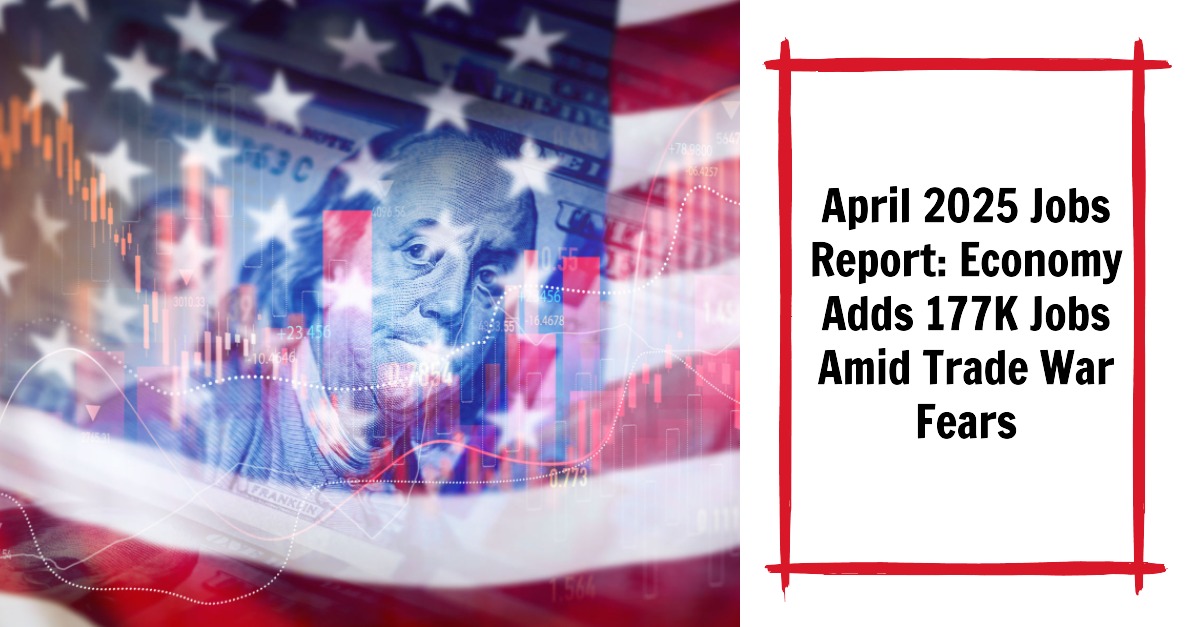The April 2025 Jobs Report reveals that the U.S. economy added a respectable 177,000 jobs, and the unemployment rate remained steady at 4.2%. This good news comes amidst concerns about the potential impact of tariffs on the economy, leaving the Federal Reserve in a wait-and-see mode regarding future interest rate adjustments.
It's always exciting to dive into the jobs report each month. It gives us a snapshot of where the economy is at, and it's something I follow closely. This month's report, though, is a bit more nuanced than usual because we have to consider the impact of tariffs alongside the raw job numbers.
April 2025 Jobs Report: A Solid Pace Amidst Tariff Uncertainty
Why the April Jobs Report Matters
The jobs report is more than just a number; it's a health check for the U.S. economy. It tells us how many people are working, where jobs are being created, and if wages are going up. This information helps everyone from the Federal Reserve to small business owners make informed decisions. It's kind of like reading the weather forecast – you might not like what it says, but it helps you prepare for what's coming.
Here's why this particular report is grabbing headlines:
- Healthy Job Growth: Adding 177,000 jobs is a solid number, showing that businesses are still hiring and the economy is moving forward.
- Tariff Concerns: President Trump's tariffs are looming, and there's worry they could slow down the economy or raise prices for consumers. The report provides early hints, but the full impact is yet to be seen.
- Fed's Next Move: The Federal Reserve is watching the data closely to decide whether to cut interest rates. This report influences their decision, potentially impacting borrowing costs for businesses and individuals.
Breaking Down the Numbers: Key Takeaways from the April 2025 Jobs Report
Here's a closer look at what the report revealed:
- Total Nonfarm Payrolls: Rose by 177,000 in April.
- Unemployment Rate: Remained unchanged at 4.2%.
- Average Hourly Earnings: Increased by 6 cents, or 0.2%, to $36.06.
Digging Deeper: What the Numbers Really Mean
Okay, so we know the numbers, but what do they mean?
- Job Creation: The 177,000 jobs added is a good sign, although it's a slight dip from the revised March figure of 185,000. It signals that the economy is still creating jobs, but the pace might be slowing down a bit.
- Unemployment: A steady unemployment rate of 4.2% is considered low and indicates a tight labor market. This means it's harder for businesses to find workers, which can potentially push wages higher.
- Wages: The modest increase in average hourly earnings suggests that wage growth is still relatively tame. While workers always want to see their paychecks increase, slow and steady wage growth can help keep inflation in check.
Sector Spotlight: Where the Jobs Are (and Aren't)
Not all sectors are created equal when it comes to job growth. Here's where the April report showed gains and losses:
- Healthcare: Continues to be a strong performer, adding 51,000 jobs in April. This reflects the ongoing demand for healthcare services as the population ages.
- Transportation and Warehousing: Showed positive hiring numbers, likely driven by the continued growth of e-commerce and the need to move goods around the country.
- Financial Activities: Positive hiring numbers.
- Social Assistance: Positive hiring numbers.
- Federal Government: Experienced a decline of 9,000 jobs in April, and has shed 26,000 jobs since January, continuing a trend of government cutbacks.
The Tariff Factor: A Cloud Over the Economic Horizon
The big question mark hanging over this jobs report is the potential impact of President Trump's tariffs. Here's what we know:
- Tariffs on Hold (for Now): While tariffs were announced earlier in the year, some are paused until July. This gives businesses and the Fed some breathing room to assess the situation.
- Escalating Tensions: Tensions between the U.S. and China have increased, with tariffs on U.S.-bound goods from China rising to 145%. This could potentially raise costs for businesses and consumers.
- Waiting for Data: It's likely too soon to see the full impact of the tariffs in the April jobs report. The Fed is closely watching the data for clues about whether the tariffs will lead to higher inflation or slower economic growth.
The Fed's Dilemma: Rates on Hold, But For How Long?
The jobs report plays a crucial role in the Federal Reserve's decision-making process when it comes to interest rates. Here's the situation:
- Rates on Hold: The solid job growth in April makes it likely that the Fed will keep interest rates steady at its upcoming May and June meetings.
- July Cut Possible?: However, the bond market is starting to price in a higher probability of a rate cut in July. As of this report, bond futures traders are pricing in a chance of over 56% for a Fed rate cut in July.
- Data Dependent: The Fed will likely wait until July to make any moves, as they need more data to gauge the inflationary consequences of the tariffs.
Why the Fed is Playing the Waiting Game
The Federal Reserve wants to avoid making any knee-jerk reactions. Cutting interest rates too soon could fuel inflation, while waiting too long could stifle economic growth. They're trying to find that sweet spot, and that requires carefully analyzing all the available data.
My Take on the April 2025 Jobs Report
Overall, I think the April 2025 Jobs Report paints a picture of an economy that's still performing well, but facing some potential headwinds. The solid job growth is encouraging, but the uncertainty surrounding tariffs is a real concern.
- Good News: The U.S. economy is still chugging along, creating jobs and keeping unemployment low. This is a testament to the resilience of American businesses and workers.
- Cause for Caution: The tariffs are a wild card. If they escalate, they could definitely put a damper on economic growth and raise prices for consumers.
- Watching the Fed: The Federal Reserve has a tough job ahead of them. They need to carefully balance the risks of inflation and slower growth, and they'll be relying heavily on the data in the coming months.
What to Watch For in the Coming Months
Here are a few things I'll be keeping an eye on:
- Tariff Impact: I'll be looking for signs that the tariffs are starting to affect consumer spending, business investment, and inflation.
- Wage Growth: Will wages start to accelerate as the labor market remains tight? This could put upward pressure on inflation.
- Global Economy: The U.S. economy doesn't operate in a vacuum. I'll be watching the global economy for signs of strength or weakness, as this can impact U.S. growth.
- Federal Reserve Decisions: If the Fed decides to cut rates, it will be interesting to see how the market reacts.
Final Thoughts
The April 2025 Jobs Report provides a valuable snapshot of the U.S. economy at a crucial moment. While the headline numbers are positive, it's important to look beyond the surface and consider the potential impact of tariffs. The coming months will be critical as we see how these factors play out and how the Federal Reserve responds.
Work With Norada – Build Wealth
With economists warning of stagflation and weak Q1 GDP due to tariffs, now is the time to invest in stable, income-generating real estate for financial security.
Norada’s turnkey rental properties provide consistent cash flow and long-term wealth, no matter the economic climate.
Speak with our expert investment counselors (No Obligation):
(800) 611-3060
Read More:
- Bond Market Today and Outlook for 2025 by Morgan Stanley
- The Risk of New Tariffs: Will They Crash the Stock Market and Economy?
- Stagflation Alert: Economist Survey Predicts Weak Q1 GDP Due to Tariffs
- Goldman Sachs Significantly Raises Recession Probability by 35%
- 2008 Crash Forecaster Warns of DOGE Triggering Economic Downturn
- Stock Market Predictions 2025: Will the Bull Run Continue?
- Stock Market Crash: Nasdaq 100 Tanks 3.5% Amid AI Concerns
- Stock Market Crash Prediction With Huge Discounts on Bitcoin, Gold, Houses
- S&P 500 Forecast for the Next Year: What to Expect in 2025?
- Stock Market Predictions for the Next 5 Years
- Echoes of 1987: Is Today’s Stock Market Crash Leading to a Recession?
- Is the Bull Market Over? What History Says About the Stock Market Crash
- Wall Street Bear Predicts a Historic Stock Market Crash Like 1929
- Economist Predicts Stock Market Crash Worse Than 2008 Crisis
- Next Stock Market Crash Prediction: Is a Crash Coming Soon?
- Stock Market Crash: 30% Correction Predicted by Top Forecaster





